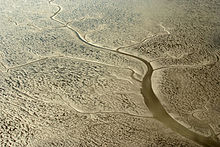Creek

A tidal creek is a natural, often meandering watercourse in the tidal flats , in the marshland and in coastal floodplains . It can be the continuation of an arm of the river from land on the Wadden Sea or it can connect different parts of the sea that are separated from each other at low tide . Deep tidal creeks, which are still navigable even at low tide, are regionally called balloons or bellows , even if they have been heavily modified by humans (such as the fairway of the Inner Jade ). The shallow, occasionally dry upper course of a creek is called a wadden channel .
There is some overlap between the terms tidal creek and deep , but no congruence.
There are also creeks where salt marshes do not merge into mud flats, e.g. B. in the bay of the Baltic Sea .
to form
Creeks in the sand mudflat are usually relatively straight, while the creeks in the mud flats often meander strongly .
habitat
The tides of the Wadden Sea of the North Sea not only form a habitat for the ubiquitous North Sea shrimp , but also for various fish species. The density of individuals generally increases from the open sea to the coast, just as it is particularly high in and near estuaries. Plaice and sand goby are present in all creeks , but some other species have specialized in certain creeks and sections of the creek. In the shallow tidal creeks and trough roots, there are mainly fish that follow the tidal movement and swarm onto the tidal flats when the tide is high; the typical Wadden Sea species can be found here. The deeper creeks form a transition area to the open North Sea.
Typical tidal creeks are estuary-shaped tidal creeks near river mouths, sand tidal creeks and two different types of mixed tidal troughs . The sand goby is most widespread on the sand floodplain, but species such as lesser sand eel and brill are also more common here. In the vicinity of the estuary there are mainly river estuary inhabitants, such as smelt , feint and the sand goby. The mixed mudflat type, which is far from estuaries, has a high number of species but small numbers of individuals and species significantly different from those found in the estuaries. For example, eel nuts are more likely to occur here. Between the estuaries and the more distant mixed tidal flats there are intermediate areas that have more individuals but fewer species than the pure mixed tidal areas and show transition phenomena from the estuary area to the pure tidal flats.
Man and creek
While tidal creeks as waters for shipping for the coastal villages on the Wadden Sea are indispensable, they provide for Wattwanderer represents a serious danger calls each year several deaths. In contrast to the assessment of many tourists, the Wadden Sea does not fill evenly at high tide, but the tides fill up first. Gutters that were only a few centimeters deep when the water level was low can reach the dimensions of a veritable river in just a few minutes. Because of their often large amounts of water, creeks have high flow speeds that overwhelm even the best swimmers.
See also
Web links
Individual evidence
- ^ National Park Office Western Pomerania: coastal bird breeding areas. Kirr Island. Extensive tidal system
- ↑ Mecklenburg-Western Pomerania service portal : DE 1747-402 Greifswalder Bodden and southern Strelasund
- ↑ Petra Witez: Final report on the research project MTK 0608 (03 KIS 3160): Programs for the long-term conservation of the Wadden Sea - Prowatt. Published by the Federal Ministry for Education and Research Laboe 2002 p. 12
- ^ A b Peter Breckling: Habitat for fish. In: Federal Environment Agency and national park administrations of Lower Saxony Wadden Sea / Schleswig-Holstein Wadden Sea (ed.): Wadden Sea Environment Atlas. Vol. 1, North Frisian and Dithmarsches Wadden Sea. Eugen Ulmer, Stuttgart 1998/1999, ISBN 3-8001-3491-8 , pp. 110-111.


